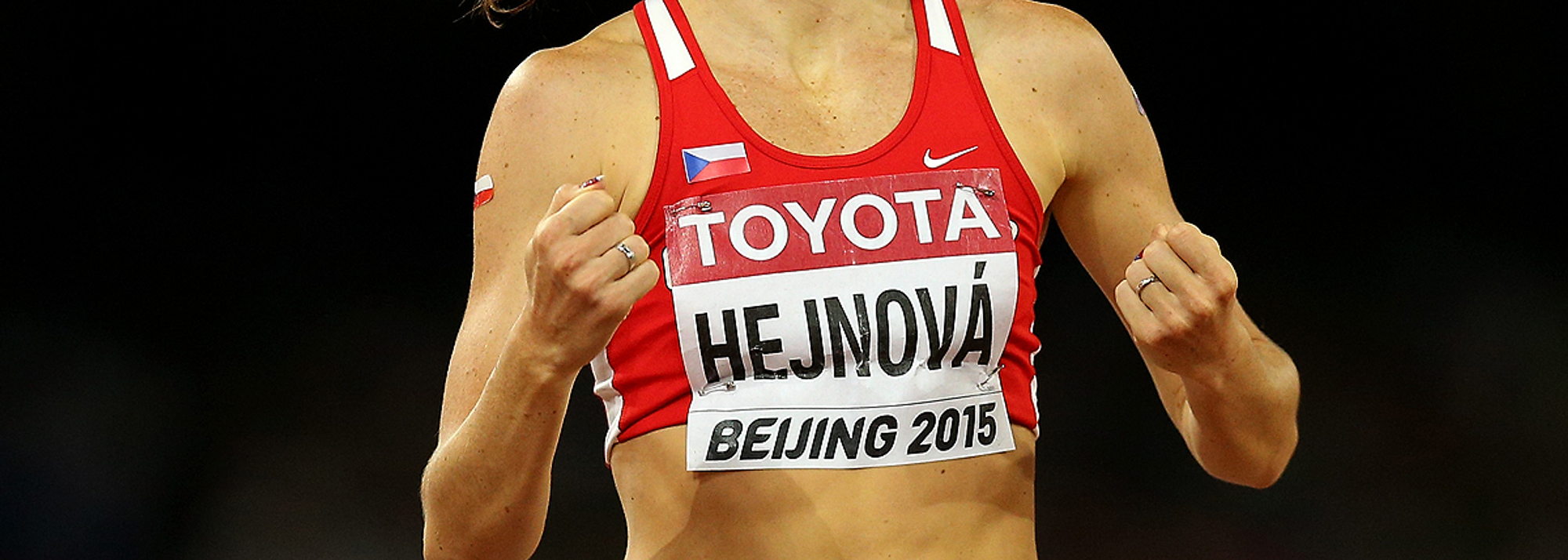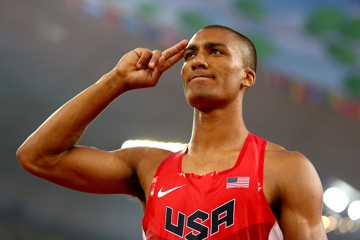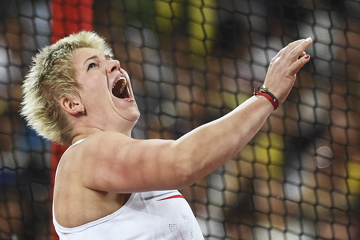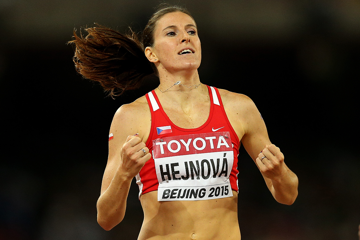Zuzana Hejnova after winning the 400m hurdles at the IAAF World Championships Beijing 2015 (© Getty Images)
Statisticians A Lennart Julin and Mirko Jalava look back on the best hurdles performances of the year.
Men’s 110m hurdles
The 110m hurdles is probably the most competitive event in the sense that there is a fairly large group of evenly-matched athletes who face each other day in and day out during the summer.
Consequently, the seven IAAF Diamond League races in 2015 saw five different winners and only in the season-ending finale in Zurich did the winning margin exceed 0.07.
The magical 13-second barrier was, for the first time ever, surpassed by four runners in the same year. Veteran David Oliver did it for the third time while Orlando Ortega, Omar McLeod and Sergey Shubenkov were new to the sub-13 club.
The event is at an all-time high in terms of depth, which is underlined by the fact that there were also three more hurdlers just missing out on going sub-13 by a few hundredths of a second.
The tightness of the top group was further illustrated at the IAAF World Championships Beijing 2015, where the three medals went to athletes who had not won any of the six preceding IAAF Diamond League races. Shubenkov, Hansle Parchment and Aries Merritt all peaked to perfection by running their fastest times of the year in the Beijing final.
The USA remains the leading nation in this event, but Jamaica and France are really putting up ever stronger challenges.
In the Beijing final, the USA was three and seven, Jamaica two and six and France had three finalists who did not win medals.
The season-long Diamond Race went to Oliver, who won at the IAAF Diamond League meetings in Shanghai and New York.
Men’s 400m hurdles
In contrast to its closest relatives – the 400m and the 110m hurdles – this event currently lacks the usual top quality and in the past two years together there has been only one single performance below 48 seconds.
However, this year it was perfectly timed as Nicholas Bett – despite running ‘blind’ in the outside lane – took off a full half-second from his best when flying around Beijing’s Bird’s Nest stadium to the gold medal in 47.79.
Bett’s triumph was one of the major sensations of the whole championships, as he had only once before been under even 49 seconds.
In the lead-up to the World Championships, Bershawn Jackson (three wins, one second place in the IAAF Diamond League) and Johnny Dutch (two wins, one third place) had shown the best consistency but both these experienced USA runners were eliminated early in Beijing.
Instead, the whole podium was a complete surprise with Bett being joined by Russia’s Denis Kudryavtsev, who lowering his pre-Beijing best by 0.61 to 48.05 for the silver medal, and The Bahamas’ Jeffery Gibson, who improved his best by 0.34 to 48.17 for the bronze.
It will be interesting to see if the old guard of Jackson, Dutch, Javier Culson, Michael Tinsley or Kerron Clement will be able to reclaim podium positions of yesteryear in Rio or if the Beijing results preclude a new generation coming through permanently.
Next year, Beijing finalists Boniface Tumuti and Patryk Dobek, as well as Thomas Barr, may well make a major breakthrough from their current level.
Jackson’s early season from was enough to secure him the Diamond Race although Gibson won the final in Brussels.
Women’s 100m hurdles
It was an extraordinary summer with seriously fast times early in the season by two Americans and then a most unexpected winner in Beijing with a relatively modest result.
Jasmin Stowers was the first one out of her blocks. The 24-year-old only had a 12.71 personal best before 2015, but the US indoor title in 7.84 in 60m hurdles clearly indicated she had made progress.
Nevertheless, running a world-leading 12.40 at the Drake Relays at the end of April still caused shockwaves as Stowers cut 0.31 seconds off her personal best in just one meeting and immediately followed that with another 12.39 in Kingston and then 12.35 in at the IAAF Diamond League in Doha a week later.
However, Stowers stumbled in her next competition in Rome in June and never got back to the same form, also missing qualifying for the US team for the world championships.
The Rome race also saw Australia’s London 2012 Olympic Games champion Sally Pearson fall and severely break her left wrist in the same race, which ended her season.
From this point, it was the turn of Sharika Nelvis to be the one on top.
The 25-year-old flew to a time of 12.34 in the heats of the US trials, which would stand up as the fastest time in 2015, although she could only finished third in the US trials final and went on to finish eighth in Beijing.
With such fast times on the table, what happened in Beijing was a shock.
The favourites were falling right and left during the three rounds, and through the debris 23-year-old Jamaican Danielle Williams emerged to snatch an unexpected gold medal in a personal best of 12.57,
the slowest winning time at a world championships since Helsinki 2005 when there was cold and rainy weather.
Germany’s Cindy Roleder was as big a surprise, getting silver in a 12.59 PB, while Alina Talay won the bronze for Belarus in a national record 12.66.’
Women’s 400m hurdles
USA’s 20-year-old 2014 world junior champion Shamier Little was the talk of the early season with her long win-streak but despite winning at the US trials and Pan American Games, it was thought she might not do as well in Beijing owing to her very long season.
However, the Texas A&M student proved everyone wrong in Beijing and after some trouble in the heats and semi-final, she ended with a perfect race in the final, where she won the silver medal in 53.94, just 0.2 seconds slower than the 53.74 personal best she clocked for the NCAA title in June.
The person who beat her though, Czech Republic’s Zuzana Hejnova, was the clear number one in this event.
The 28-year-old suffered two early season defeats with third place finishes at IAAF Diamond League meetings in Birmingham and Oslo but these were followed by four straight wins before Beijing and there she had absolutely no trouble in successfully defending her 2013 world title in the final, which she won in a world-leading time of 53.50.
Hejnova capped her 2015 season with another win in Zurich to also take the Diamond Race,
This year’s revelation in this event was Denmark's 28-year-old Sara Petersen, who became a mother in 2013 and returned to competition during 2014.
Her outdoor opener was 55.73, was a mere 0.05 off her 2012 national record and she went on to improve this mark in her next four races: 55.23 in Geneva, 55.13 in Stara Zagora, 54.79 in Sopot and then a stunning 53.99 finish behind Hejnova at the IAAF Diamond League meeting in Paris.
Petersen finished in fourth place in Beijing in 54.20, just losing the bronze medal to the USA’s Cassandra Tate, who clocked 54.02 for third and just 0.01 off her personal best set at the US Championships and Beijing trials in June.
A Lennart Julin (men’s events) and Mirko Jalava (women’s events) for the IAAF







